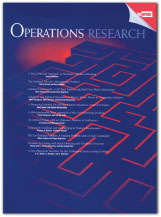Academic articles
Practitioner articles
Working papers
Books
Book chapters
Case studies
Other publications
Subject(s)
Economics, politics and business environment
Keyword(s)
Retail competition, externalities, free-riding, vertical restraints, cross-channel shopping, competition law
JEL Code(s)
K21, L42, L81
Volume
4
Journal Pages
42–83
Subject(s)
Management sciences, decision sciences and quantitative methods; Product and operations management
Keyword(s)
Dynamic mechanism design, optimal control, asymmetric information, environmental regulation, voluntary disclosure
This paper studies the design of voluntary disclosure regulations for a firm that faces a stochastic environmental hazard. The occurrence of such a hazard is known only to the firm. The regulator, if finding a hazard, collects a fine and mandates the firm to perform costly remediation that reduces the environmental damage. The regulator may inspect the firm at any time to uncover the hazard. However, because inspections are costly, the regulator also offers a reward to the firm for voluntarily disclosing the hazard. The reward corresponds to either a subsidy or a reduced fine, depending on whether it is positive or negative. Thus, the regulator needs to dynamically determine the reward and inspection policy that minimizes expected societal cost in the long run. We model this problem as a dynamic adverse selection problem with costly state verification in continuous time. Despite the complexity and generality of this setup, we show that the optimal regulation policy follows a very simple cyclic structure, which we fully characterize in closed form. Specifically, the regulator runs scheduled inspections periodically. After each inspection, the reward level decreases over time until a subsequent inspection takes place. If a hazard is not revealed, the reward level is reset to a high level, restarting the cycle. In contrast to the reward level, the mandated remediation level is constant over time. Nonetheless, when subsidies are not allowed in the industry, we show that the regulator should dynamically adjust this remediation level, which then acts as a substitute for a subsidy. Our analysis further reveals that optimal inspection frequency increases not only when the inspection accuracy decreases, but also when the penalty for not disclosing the hazard increases.
© 2016 INFORMS
Volume
64
Journal Pages
371–389
Subject(s)
Economics, politics and business environment
Keyword(s)
Labor contracts, incentives, behavioral economics, plantations
JEL Code(s)
D82, D86, J33, J41, J43, O13, Q12
We study a contract change for tea pluckers on an Indian plantation, with a higher government-stipulated baseline wage. Incentive piece rates were lowered or kept unchanged. Yet, in the following month, output increased by 20 to 80 percent. This response contradicts the standard model and several variants, is only partly explicable by greater supervision, and appears to be "behavioral." But in subsequent months, the increase is comprehensively reversed. Though not an unequivocal indictment of "behavioral" models, these findings suggest that nonstandard responses may be ephemeral, and should ideally be tracked over an extended period of time.
Copyright © 2016 by the American Economic Association.
Volume
106
Journal Pages
316–358
Subject(s)
Entrepreneurship
Keyword(s)
Microeconomic behavior, industrial organization, firm objectives, organization and behavior, market structure, firm strategy, market performance, patent system, patent litigation
JEL Code(s)
K11, K41, O34
Postgrant validity challenges at patent offices rely on the private initiative of third parties to correct mistakes made by patent offices. We hypothesize that incentives to bring postgrant validity challenges are reduced when many firms benefit from revocation of a patent and when firms are caught up in patent thickets. Using data on opposition to patents at the European Patent Office we show that opposition decreases in fields in which many others profit from patent revocations. Moreover, in fields with a large number of mutually blocking patents, the incidence of opposition is sharply reduced, particularly among large firms and firms that are caught up directly in patent thickets. These findings indicate that postgrant patent review may not constitute an effective correction device for erroneous patent grants in technologies affected by either patent thickets or highly dispersed patent ownership.
© 2016 INFORMS
Volume
62
Journal Pages
704–721
ISSN (Online)
1526-5501
ISSN (Print)
0025–1909
Subject(s)
Entrepreneurship; Technology, R&D management
Keyword(s)
Patent indicators, patent system, product commercialization, pharmaceutical industry, drug development
Patent-based measures are frequently used as indicators in empirical research on innovation and technological change. Currently, there is little evidence as to what extent patent-based indicators relate to product market outcomes. Using a unique dataset that links outcomes from product commercialization in the pharmaceutical industry with detailed patent data, we relate patent-based indicators that capture either an invention’s value or the uncertainty surrounding the patenting process to the outcomes of the product development process. Our findings suggest that the speed of commercialization increases with value but reduces with uncertainty. Using a variety of alternative indicators we derive implications for the use and the proper interpretation of individual measures. Moreover, our study has broader implications as it highlights the detrimental effect of uncertainty on the speed of innovation.
With permission of Elsevier
Volume
45
Journal Pages
1091–1102
Subject(s)
Management sciences, decision sciences and quantitative methods; Product and operations management
Keyword(s)
Technology diffusion, government incentive policies, renewable energy technology, feed-in tariff, learning-by-doing, dynamic programming
Feed-in-tariff (FIT) policies aim at driving down the cost of renewable energies by fostering learning and accelerating the diffusion of green technologies. Under FIT mechanisms, governments purchase green energy at tariffs that are set above market price. The success or failure of FIT policies, in turn, critically depend on how these tariffs are determined and adjusted over time. This paper provides insights into designing cost-efficient and socially-optimal FIT programs. Our modeling framework captures key market dynamics as well as investors' strategic behavior. In this framework, we establish that the current practice of maintaining constant profitability is theoretically rarely optimal. By contrast, we characterize a no-delay region in the problem's parameters, such that profitability should strictly decrease over time if the diffusion and learning rates belong to this region. In this case, investors never strategically postpone their investment to a later period. When the diffusion and learning rates fall outside the region, profitability should increase at least temporarily over some time periods and strategic delays occur. The presence of strategic delays, however, makes the practical problem of computing optimal FIT schedules very difficult. To address this issue, the regulator may focus on policies that disincentivize investors to postpone their investment. With this additional constraint, a constant profitability policy is optimal if and only if the diffusion and learning rates fall outside the no-delay region. This provides partial justifications for current FIT implementations.
© 2015 INFORMS
Volume
64
Journal Pages
52–66
Subject(s)
Product and operations management
Keyword(s)
Mergers, supply chain, differentiated products, market power, operational synergy
This paper studies the implications of upstream and/or downstream horizontal mergers on suppliers, retailers and consumers, in a bilateral oligopolistic system. We especially focus on market power and operational synergy benefits that such mergers engender. Starting with a benchmark pre-merger scenario in which firms compete on prices at each level, we find that the above two consequences individually almost have opposite effects on the merging and non-merging firms’ optimal decisions/profits after a merger. Furthermore, even though the effects of upstream and downstream mergers are different, the vertical supply chain partners will always try to reduce their losses if the market power effect dominates, but will take actions that improve their profits if the synergy effect is stronger. The above results are robust enough to hold even when taking into account intra-brand competition among retailers.
With permission of Elsevier
Volume
249
Journal Pages
131–143
Subject(s)
Ethics and social responsibility; Marketing
This paper reviews the substantial body of work on corporate social responsibility (CSR), including the synonymous domains of cause-related marketing and ethical consumption, to synthesizes the diverse findings on consumer responses to CSR. CSR is capable of engendering a range of company-favoring perceptions and behaviors, driven by both consumers’ CSR-related motivations (e.g., consumer-company identification, affective motives) and their CSR-guided product perceptions. As well, the paper documents the plethora of CSR initiative-, company-, and consumer-specific factors that modulate consumers’ reactions to CSR initiatives, and ends with a discussion of some key future research directions.
With permission of Elsevier
Volume
10
Journal Pages
70–75
Subject(s)
Economics, politics and business environment
Keyword(s)
Consumer naivete, innovation, exploitative contracting,
consumer protection, retail finance
JEL Code(s)
D21, G21, L11, L25, O31
We analyze innovation incentives when firms can invest either in increasing the product's value (value-increasing innovation) or in increasing the hidden prices they collect from naive consumers (exploitative innovation). We show that if firms cannot return all profits from hidden prices by lowering transparent prices, innovation incentives are often stronger for exploitative than for value-increasing innovations, and are strong even for non-appropriable innovations. These results help explain why firms in the financial industry (e.g. credit-card issuers) have been willing to make innovations others could easily copy, and why these innovations often seem to have included exploitative features.
Copyright © 2015 by the American Economic Association.
Volume
8
Journal Pages
1–23
Subject(s)
Technology, R&D management
Keyword(s)
Servitization, smart technology, manufacturing, services, service operations
Remote monitoring technology (RMT) is widely acknowledged as an important enabler of servitization however, there is a dearth of understanding about how RMT is used by manufacturing firms to support servitized strategies. This paper aims to contribute to this important yet somewhat ignored topic in servitization research. It attempts to address the following questions: What has constrained, and what has enabled the exploitation of RMT in the context of servitized strategies?
The research adopts an exploratory multiple-case study design. Four in-depth descriptive case studies of companies operating in aerospace, industrial equipment, marine, and transport sectors were conducted. The collected data was analysed and synthesised, drawing out conclusions.
With permission of Emerald
Volume
27
Journal Pages
154–184



